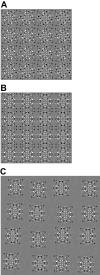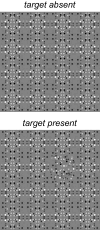Visual search efficiency is modulated by symmetry type and texture regularity
- PMID: 40358586
- PMCID: PMC12110545
- DOI: 10.1167/jov.25.6.7
Visual search efficiency is modulated by symmetry type and texture regularity
Abstract
More than a century of vision research has identified symmetry as a fundamental cue, which aids the visual system in making inferences about objects and surfaces in natural scenes. Most studies have focused on one type of symmetry, reflection, presented at a single image location. However, the visual system responds strongly to other types of symmetries and to symmetries that are repeated across the image plane to form textures. Here we use a visual search paradigm with arrays of repeating unit cells that contained either reflection or rotation symmetries but were otherwise matched. Participants were asked to report the presence of a target tile without symmetry. When unit cells tile the plane without gaps, they form regular textures. We manipulated texture regularity by introducing jittered gaps between unit cells. This paradigm lets us investigate the effect of symmetry type and texture regularity on visual search efficiency. Based on previous findings suggesting an advantage for reflection in visual processing, we hypothesized that search would be more efficient for reflection than rotation. We further hypothesized that regular textures would be processed more efficiently. We found independent effects of symmetry type and regularity on search efficiency that confirmed both hypotheses: Visual search was more efficient for textures with reflection symmetry and more efficient for regular textures. This provides additional support for the perceptual advantage of reflection in the context of visual search and provides important new evidence in favor of visual mechanisms specialized for processing symmetries in regular textures.
Figures






Similar articles
-
Representation of Maximally Regular Textures in Human Visual Cortex.J Neurosci. 2016 Jan 20;36(3):714-29. doi: 10.1523/JNEUROSCI.2962-15.2016. J Neurosci. 2016. PMID: 26791203 Free PMC article.
-
The human visual system preserves the hierarchy of two-dimensional pattern regularity.Proc Biol Sci. 2021 Jul 28;288(1955):20211142. doi: 10.1098/rspb.2021.1142. Epub 2021 Jul 21. Proc Biol Sci. 2021. PMID: 34284623 Free PMC article.
-
Different symmetries, different mechanisms.Atten Percept Psychophys. 2023 Jan;85(1):166-173. doi: 10.3758/s13414-022-02599-9. Epub 2022 Nov 30. Atten Percept Psychophys. 2023. PMID: 36451078 Free PMC article.
-
Symmetry and its transition in phyllotaxis.J Plant Res. 2021 May;134(3):417-430. doi: 10.1007/s10265-021-01308-1. Epub 2021 Apr 28. J Plant Res. 2021. PMID: 33913052 Review.
-
The neural basis of visual symmetry and its role in mid- and high-level visual processing.Ann N Y Acad Sci. 2018 Mar 31. doi: 10.1111/nyas.13667. Online ahead of print. Ann N Y Acad Sci. 2018. PMID: 29604083 Review.
Cited by
-
Metacontrast masking of symmetric stimuli.PLoS One. 2025 Aug 7;20(8):e0330019. doi: 10.1371/journal.pone.0330019. eCollection 2025. PLoS One. 2025. PMID: 40773503 Free PMC article.
References
-
- Adelson, E. H. (2001). On seeing stuff: The perception of materials by humans and machines. Human Vision and Electronic Imaging VI, 4299, 1–12, 10.1117/12.429489. - DOI
-
- Bahnsen, P. (1928). Ein Untersuchung über Symmetrie und Asymmetrie bei visuellen Wahrnehmungen. Princeton, NJ: Lippert.
LinkOut - more resources
Full Text Sources

